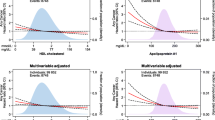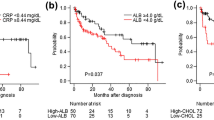Summary
Background
Multiple myeloma (MM) staging is based on beta‑2 MG, albumin, LDH levels, and the presence of chromosomal abnormalities. We aimed to evaluate the impact of high-density lipoprotein (HDL) on myeloma outcomes.
Materials and methods
This study included 148 individuals; 68 patients diagnosed with MM and 80 age, sex, comorbidity-matched controls. The relationship between HDL and myeloma stage and the association between HDL and progression-free survival (PFS) were analyzed.
Results
Sixty-five percent of patients were male in each group. Mean HDL level was higher in the control group than myeloma group (52.6 ± 15.02 mg/dl versus 33.79 ± 12.71) (p < 0.001). According to ISS, 39 patients (57%) had advanced stage (ISS-III) disease. To assess the optimal cut-point for HDL that makes a difference in PFS, the X‑tile software program was used and in line with the created plots, the myeloma cohort was divided into two groups as HDL < 28 and ≥ 28 mg/dl. Twenty-two patients (32.4%) were in HDL < 28 group. According to the ISS, HDL < 28 group had more advanced disease than the HDL ≥ 28 group (p = 0.008). Twenty-nine patients (42.6%) progressed or died during the follow-up and 15 of these were in the HDL < 28 group. Time to progression was shorter in patients who were in the HDL < 28 group (median, 22 versus 40 months, p = 0.03). There was no statistically significant difference between these groups in terms of overall survival (p = 0.708).
Conclusion
Myeloma patients have lower HDL than controls and HDL < 28 mg/dl associates with advanced-stage disease and shorter PFS. Therefore, HDL can be a surrogate prognostic marker in myeloma.




Similar content being viewed by others
References
Greipp PR, Miguel JS, Durie BG, Crowley JJ, Barlogie B, Bladé J, Boccadoro M, Child JA, Avet-Loiseau H, RAJJoco K. International staging system for multiple myeloma. J Clin Oncol. 2005;23(15):3412–20. https://doi.org/10.1200/JCO.2005.04.242.
Palumbo A, Avet-Loiseau H, Oliva S, Lokhorst HM, Goldschmidt H, Rosinol L, Richardson P, Caltagirone S, Lahuerta JJ, Facon T. Revised international staging system for multiple myeloma: a report from International Myeloma Working Group. J Clin Oncol. 2015;33(26):2863–9. https://doi.org/10.1200/JCO.2015.61.2267.
Rajkumar SV, Dimopoulos MA, Palumbo A, Blade J, Merlini G, Mateos M‑V, Kumar S, Hillengass J, Kastritis E, Richardson P. International Myeloma Working Group updated criteria for the diagnosis of multiple myeloma. Lancet Oncol. 2014;15(12):e538–e48. https://doi.org/10.1016/S1470-2045(14)70442-5.
Yang S, Damiano MG, Zhang H, Tripathy S, Luthi AJ, Rink JS, Ugolkov AV, Singh AT, Dave SS, Gordon LI. Biomimetic, synthetic HDL nanostructures for lymphoma. Proc Natl Acad Sci USA. 2013;110(7):2511–6. https://doi.org/10.1073/pnas.1213657110.
Li HY, Appelbaum FR, Willman CL, Zager RA, Banker DE. Cholesterol-modulating agents kill acute myeloid leukemia cells and sensitize them to therapeutics by blocking adaptive cholesterol responses. Blood. 2003;101(9):3628–34. https://doi.org/10.1182/blood-2002-07-2283.
Goncalves RP, Rodrigues DG, Maranhao RC. Uptake of high density lipoprotein (HDL) cholesteryl esters by human acute leukemia cells. Leuk Res. 2005;29(8):955–9. https://doi.org/10.1016/j.leukres.2005.01.013.
Jafri H, Alsheikh-Ali AA, Karas RH. Baseline and on-treatment high-density lipoprotein cholesterol and the risk of cancer in randomized controlled trials of lipid-altering therapy. J Am Coll Cardiol. 2010;55(25):2846–54. https://doi.org/10.1016/j.jacc.2009.12.069.
Mogilenko DA, Shavva VS, Dizhe EB, Orlov SV, Perevozchikov AP. PPARγ activates ABCA1 gene transcription but reduces the level of ABCA1 protein in HepG2 cells. Biochem Biophys Res Commun. 2010;402(3):477–82. https://doi.org/10.1016/j.bbrc.2010.10.053.
Jeong SM, Choi T, Kim D, Han K, Kim SJ, Rhee SY, Giovannucci EL, Shin DW. Association between high-density lipoprotein cholesterol level and risk of hematologic malignancy. Leukemia. 2021;35(5):1356–64. https://doi.org/10.1038/s41375-020-01081-5.
Ganjali S, Ricciuti B, Pirro M, Butler AE, Atkin SL, Banach M, Sahebkar A. High-density lipoprotein components and functionality in cancer: state-of-the-art. Trends Endocrinol Metab. 2019;30(1):12–24. https://doi.org/10.1016/j.tem.2018.10.004.
Kuliszkiewicz-Janus M, Malecki R, Mohamed AS. Lipid changes occuring in the course of hematological cancers. Cell Mol Biol Lett. 2008;13(3):465–74. https://doi.org/10.2478/s11658-008-0014-9.
Yavasoglu I, Tombuloglu M, Kadikoylu G, Donmez A, Cagirgan S, Bolaman Z. Cholesterol levels in patients with multiple myeloma. Ann Hematol. 2008;87(3):223–8. https://doi.org/10.1007/s00277-007-0375-6.
Ozturk E. The relationship between hematological malignancy and lipid profile. Medeni Med J. 2021;36(2):146. https://doi.org/10.5222/MMJ.2021.91145.
Poorey VK, Thakur P. Alteration of lipid profile in patients with head and neck malignancy. Indian J Otolaryngol Head Neck Surg. 2016;68(2):135–40. https://doi.org/10.1007/s12070-015-0829-4.
Shen JG, Jin LD, Dong MJ, Wang LB, Zhao WH, Shen J. Low level of serum high-density lipoprotein cholesterol in gastric cancer correlates with cancer progression but not survival. Transl Cancer Res TCR. 2020;9(10):6206–13. https://doi.org/10.21037/tcr-20-1220.
Liu X, Xu P, Wang L, Zhang C, Wang M, Ouyang J, Chen B. Cholesterol levels provide prognostic information in patients with multiple myeloma. Clin Lab. 2020; https://doi.org/10.7754/Clin.Lab.2019.190824.
Cartier S, Zhang B, Rosen VM, Zarotsky V, Bartlett JB, Mukhopadhyay P, Wagner S, Davis C. Relationship between treatment effects on progression-free survival and overall survival in multiple myeloma: a systematic review and meta-analysis of published clinical trial data. Oncol Res Treat. 2015;38(3):88–94. https://doi.org/10.1159/000375392.
Liang L, Li J, Fu H, Liu X, Liu P. Identification of high serum apolipoprotein A1 as a favorable prognostic indicator in patients with multiple myeloma. J Cancer. 2019;10(20):4852–9. https://doi.org/10.7150/jca.31357.
Wang H, Chen B, Shao R, Liu W, Xiong L, Li L, Lu Y. A new prediction model integrated serum lipid profile for patients with multiple myeloma. Cancer. 2022;13(6):1796–807. https://doi.org/10.7150/jca.69321.
Gordon DJ. Factors affecting high-density lipoproteins. Endocrinol Metab Clin North Am. 1998;27(3):699–709. https://doi.org/10.1016/S0889-8529(05)70034-7.
Acknowledgements
We thank all of our colleagues and also patients for their assistance.
Funding
This paper was not funded.
Author information
Authors and Affiliations
Contributions
IEÖ, EK, TE, and EÖ performed the research and analyzed and interpreted the data. IEÖ and EK created the figures and wrote the manuscript. IEÖ and TE performed the data analyses and EÖ reviewed the manuscript. All authors reviewed the results and approved the final version of the manuscript.
Corresponding author
Ethics declarations
Conflict of interest
I. Erdoğan Özünal, E. Kılıçaslan, T. Elibol and E. Öztürk declare that they have no competing interests.
Ethical standards
The study was approved by the local ethics committee of Medeniyet University and approved by the provincial health directorate, Istanbul, per the ethical standards formulated in the Declaration of Helsinki. Informed consent was obtained from all patients.
Additional information
Publisher’s Note
Springer Nature remains neutral with regard to jurisdictional claims in published maps and institutional affiliations.
Data availability
The datasets used and/or analyzed during the current study are available from the corresponding author on reasonable request.
Code availability
Not applicable
Rights and permissions
About this article
Cite this article
Erdoğan Özünal, I., Kılıçaslan, E., Elibol, T. et al. High-density lipoprotein (HDL) has an impact on myeloma outcome: Lower HDL associates with worse progression-free survival. Wien Klin Wochenschr (2023). https://doi.org/10.1007/s00508-023-02239-8
Received:
Accepted:
Published:
DOI: https://doi.org/10.1007/s00508-023-02239-8




